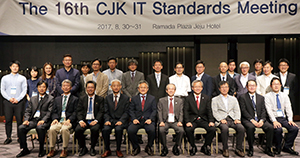 |
|
|
|
|
|
Global Standardization Activities Vol. 16, No. 2, pp. 58–60, Feb. 2018. https://doi.org/10.53829/ntr201802gls Report on 16th CJK (China, Japan, and Korea) IT Standards Plenary MeetingAbstractThe 16th CJK IT (information technology) Standards Meeting was held in Jeju, Korea, on August 30 and 31, 2017. The meeting is attended by members of four domestic standards bodies from the participating countries of China, Japan, and Korea: TTA (Telecommunications Technology Association) of Korea, CCSA (China Communications Standards Association) of China, ARIB (Association of Radio Industries and Businesses) of Japan, and TTC (The Telecommunication Technology Committee) of Japan. Its purpose is to enable these bodies to share information about the standardization strategies of the respective countries. Attempts were made for the first time to shorten this and subsequent meeting periods by holding only a Plenary Meeting and a TACT (Group on Administrative Matters) meeting, which is responsible for defining rules regarding meeting administration. Keywords: CJK IT Standards Meeting, IoT, 5G 1. OverviewThe CJK IT Standards Meeting is held annually, with its venues rotating among the three countries. The previous meeting was held in Xining, China and the latest in Jeju, Korea (Photo 1). Besides TACT, the CJK Meeting currently has four working groups (WGs): NSA (Network and Service Architecture), IMT (International Mobile Telecommunications), IS (Information Security), and WPT (Wireless Power Transmission). Progress in the activities of these WGs over the last 12 months was reported at the Plenary Meeting. It was agreed in the previous Plenary not to hold WG meetings simultaneously with a Plenary Meeting and to limit the number of participants to the bare minimum (up to eight persons) in order to reduce the meeting cost and the preparation workload. As of this Plenary, the meeting period has been compressed from the previous three days to one-and-a-half days, and only Plenary and TACT meetings were held.
2. Results from Plenary MeetingThe main results of the Plenary Meeting are reported in this section. 2.1 Activity progress reports from each country’s standards bodies(1) TTA (Korea) The Telecommunications Technology Association (TTA) reported that it had a membership of 204 organizations and employs 439 persons (64 in standardization, 42 in planning, 314 in certification, and 19 in other activities). It tackled two primary standardization issues for fiscal year (FY) 2017: a hyper-connected society platform (Internet of Things (IoT), fifth-generation mobile communications systems (5G), cloud/big data, artificial intelligence, and security) and smart convergence services (realistic media, smart devices, health-related ICT (information and communication technology), smart homes, and autonomous cars). It reformed its organization to address 5G and initiated a global certification service for oneM2M. (2) CCSA (China) The China Communications Standards Association (CCSA) stated that it had 358 regular members, 13 supporting members, and 29 observers. Its main standardization issues for FY 2017 were targeted at the fields of 5G; industrial Internet and smart manufacturing; telematics and connected cars, smart cities, and cyberspace security. It also reported that as a result of a revision of the Standardization Law by the Chinese government, Consortium Standards were defined in addition to the existing National Standards and Industry Standards. (3) ARIB (Japan) The Association of Radio Industries and Businesses (ARIB) reported that it had 189 regular members and 13 supporting members. In FY 2017, its standardization activities focused on 5G, promotion of worldwide diffusion of UHDTV (ultra high-definition television) systems, and frequency spectrum adjustment for implementing ITS (intelligent transport systems). (4) TTC (Japan) With 90 regular members and 6 supporting members, the Telecommunication Technology Committee (TTC) directed its main standardization efforts at 5G, IoT, and all-IP (Internet protocol) telephone networks in FY 2017. It made a brief presentation on the IoT Innovation Promotion Committee, which was established in June 2017. 2.2 Discussions on standardization strategiesIn light of the establishment by ITU-T (International Telecommunication Union - Telecommunication Standardization Sector) of two new Focus Groups (FGs)—FG DLT (Distributed Ledger Technology) and FG DFC (Digital Fiat Currency)—and of the establishment of ISO/TC (International Organization for Standardization/Technical Committee) 307 Blockchain DLT, TTA proposed the formation of a related WG in CJK. After some discussion, it was agreed to study blockchains in an ad hoc group within the IS WG. ARIB invited Chinese and Korean companies to participate in a feasibility test driven by 5GMF (Fifth Generation Mobil Communications Promotion Forum) in Japan. It was decided to discuss this issue in the IMT WG. 3. Results from TACT meetingTACT discussed adding to the CJK Guidelines a change in the way the Plenary Meeting is held, as practiced on this occasion. The Plenary Meeting approved this change. 4. Reports from individual WGsThe reports from WGs are summarized in this section. (1) NSA WG No WG meetings have been held in the last two years. The Plenary Meeting discussed whether or not this WG should be continued, and it was decided to contact the Korean person in charge of this WG because there is a need to study non-wireless issues of 5G. (2) IMT WG The 47th meeting of this WG was held in Shanghai, China, the 48th in Busan, Korea, and the 49th in Fukuoka, Japan. The WG submitted five contributions to ITU-R (Radiocommunication Sector) Working Party 5D (IMT systems). The next meeting will be held in Suzhou, China. (3) IS WG The 12th meeting was held in Busan, Korea and the 13th in Guangzhou, China. At those meetings the issue of how ITU-T Study Group 17 should be organized in the new study period was discussed, and DLT was studied. The next meeting was scheduled for Japan in January 2018. (4) WPT WG The 13th meeting was held in Osaka, Japan and the 14th in Jeju, Korea. The WG gave its consent to the CJK Technical Report on WPT Edition 4 at the WG level and proposed it to AWG-21 (21st Meeting of the Asia-Pacific Telecommunity Wireless Group). The next meeting will be held in China. 5. Future planThe 17th Plenary Meeting will be jointly hosted by ARIB and TTC in Matsue, Japan, in October 2018. |


